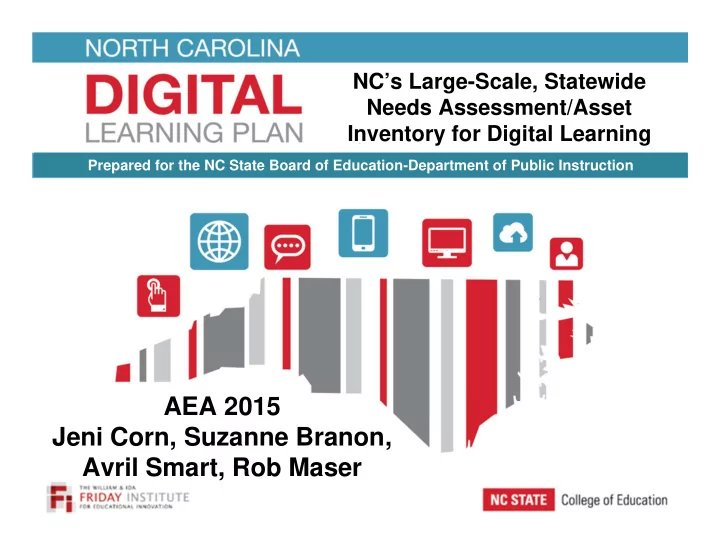

NC’s Large-Scale, Statewide Needs Assessment/Asset Inventory for Digital Learning Prepared for the NC State Board of Education-Department of Public Instruction AEA 2015 Jeni Corn, Suzanne Branon, Avril Smart, Rob Maser
http://ncdlplan.fi.ncsu.edu
A Plan to Implement Legislative Actions
Digital-Age Teaching and Learning Digital content providing interactive, Advancement based on demonstrated mastery of the content and flexible and easily updated educational resources. competency in applying what has been learned. Assessments integrated into learning activities to provide ongoing Anywhere and anytime learning , information about students’ achievement inside and outside of schools, 24/7, with that can be used to improve teaching and most learning blending face ‐ to ‐ face and learning. online activities. Parent portals provide 24/7 access to Personalized learning and flexible their children’s assignments, grades, and resources optimized for each student. records, as well as a means to communicate with teachers and Student ‐ centered instruction , administrators. combining large group, small group and individualized learning, with teachers Project ‐ based and community ‐ based serving as facilitators and coaches. learning activities connecting to students’ lives outside of school.
Guiding Principles 1. Focus on effective teaching and learning, enabled and enhanced by technology. 2. Leverage existing innovations, expertise, and resources from throughout NC. 3. Develop leadership capacity throughout the State. 4. Engage teachers, administrators, students, parents, business leaders and other stakeholders. 5. Focus on equity of educational opportunities for all students throughout NC. 6. Plan for long-term sustainability, continuous improvement, and educational return on investment.
Methodological Approach
Process and Outreach
Deep Dive Site Visits And several charter schools
Selected Findings Data Sources : • NC Teacher Working Conditions Survey (2014) • Annual Media and Technology Report (AMTR) (2015) • NC Digital Learning Progress Rubric for Districts and Charter Schools (2015) • Deep Dive District Visits (2014-15)
Technology Access Exceeds Training 2014 Teacher Working Conditions Data Teachers have sufficient access to instructional technology, including computers, printers, software and internet access. Teachers have sufficient training to fully utilize instructional technology.
684 NC Schools have a 1:1 Initiative 2015 AMTR Results 91 LEAs have at least one 1:1 school 10 LEAs are 1:1 in all schools 14 LEAs have only a single 1:1 school Growing connectivity demands
684 NC Schools have a 1:1 Initiative 2015 AMTR Results Does your school have a 1:1 program?
Only 16% of NC Schools have a Full-Time ITF 2015 AMTR Results
Less than 1/3 rd of Schools Estimate that 75% or More of their Students have Home Internet Access 2015 AMTR Results 700,000 230,000 Est. # of Students with (Blue) & 600,000 70,000 Without (Red) Access 500,000 400,000 300,000 160,000 480,000 200,000 390,000 100,000 40,000 90,000 6,000 - 0%-25% 26%-50% 51%-75% 76%-100% (5% of schools) (21% of schools) (43% of schools) (31% of schools) School Estimates of Proportion of Students with Home Access
2015 Digital Learning Progress Rubric Digital Learning Progress Rubric
LEAs are at Different Places in their Progress Toward Digital Learning 2015 NC Digital Learning Progress Rubric Results (N=22) (N=53) (N=33) (N=7)
Key Elements on Which LEAs Rate Themselves Highest Average Key Element Key Element Score L3 - Communication & Collaboration 3.0 T1 - School Networks 2.9 D3 - Authentic Assessments 2.7 L6 - Policy 2.5 T2 - End-User Devices 2.5 Note: “Key element score” is the score each LEA rated itself on a single key element. The rubric is scored on a 4-point scale: “early” (1-1.9); “developing” (2-2.9); “advanced” (3-3.9); and “target” (4). All data are self-reported.
Key Elements on Which LEAs Rate Themselves Lowest Average Key Element Key Element Score L5 - Sustainability 1.9 P3 - Professional Development 1.9 T6 - Outside of School 1.9 T5 - Supporting Services 2.0 C1 - Educator Role 2.0 Note: “Key element score” is the score each LEA rated itself on a single key element. The rubric is scored on a 4-point scale: “early” (1-1.9); “developing” (2-2.9); “advanced” (3-3.9); and “target” (4). All data are self-reported.
Summary of Recommendations
Summary of Recommendations
Budget Considerations Estimated Avg. 2014-15 NCGA 2015- NCGA 2016- Per-ADM Cost Budget 16 Budget 17 Budget Content $60 $16 $34.67 $41.33 Devices $100 - - - Connectivity $21* $13 $14.67 $21 Professional $4 - - - Learning Regional Support $3 - - - * Total connectivity cost is $64/ADM - E-rate covers $43/ADM Other Considerations : Meeting Human Capacity Needs (e.g., how to balance funding for new roles, like instructional technology facilitators and technicians; both are critical to success but only present in 16% and 11% of schools, respectively)
Final Comments • NC is positioned to be a national leader in digital learning. • There will be good long-term for the state in terms of educational outcomes, increased graduate rates, and workforce preparation. • The Digital Learning Initiative will move things in the right direction, but changes will be ongoing. • Successful implementation will require investments in infrastructure, digital content, and human capacity development.
NC Digital Learning Plan Resources http://ncdlplan.fi.ncsu.edu/ Jeni Corn, Director of Evaluation Programs, Friday Institute for Educational Innovation, NC State University, jocorn@ncsu.edu
Recommend
More recommend